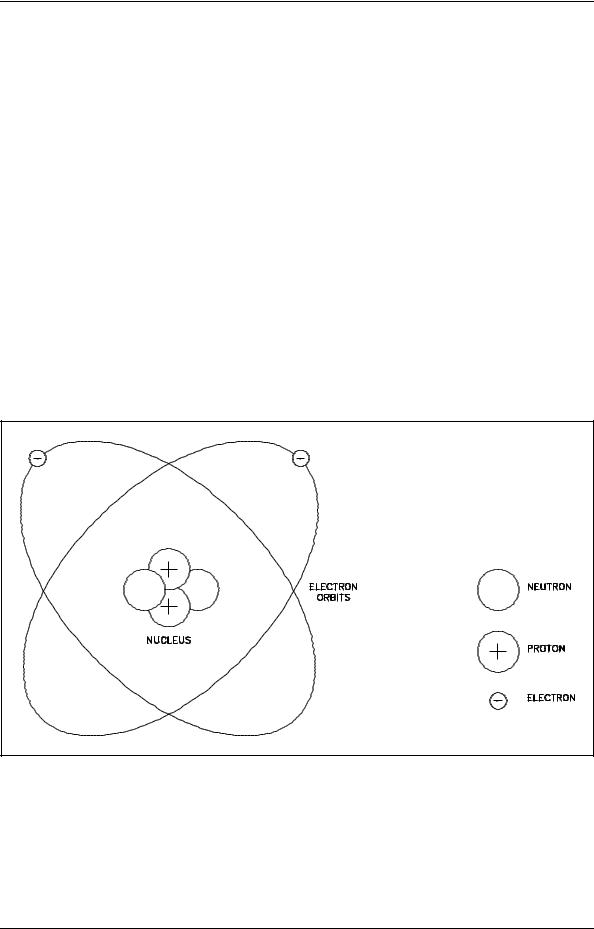
- •ABSTRACT
- •FOREWORD
- •OVERVIEW
- •TABLE OF CONTENTS
- •LIST OF FIGURES
- •LIST OF TABLES
- •REFERENCES
- •OBJECTIVES
- •CHARACTERISTICS OF ATOMS
- •Characteristics of Matter
- •The Atom Structure
- •Chemical Elements
- •Molecules
- •Avogadro's Number
- •The Mole
- •Mole of Molecules
- •Summary
- •THE PERIODIC TABLE
- •Periodic Table
- •Classes of the Periodic Table
- •Group Characteristics
- •Atomic Structure of Electrons
- •Summary
- •CHEMICAL BONDING
- •Chemical Bonding
- •Ionic Bonds
- •Covalent Bonds
- •Metallic Bonds
- •Van der Waals Forces
- •Organic Chemistry
- •Alkanes
- •Alkenes
- •Alkynes
- •Aromatics
- •Alcohols
- •Aldehydes
- •Basic Chemical Laws
- •Forming Chemical Compounds
- •Combining Elements
- •Summary
- •CHEMICAL EQUATIONS
- •Le Chatelier's Principle
- •Density
- •Molarity
- •Normality
- •Parts per Million
- •Chemical Equations
- •Balancing Chemical Equations
- •Summary
- •ACIDS, BASES, SALTS, AND pH
- •Acids
- •Bases
- •Salts
- •Dissociation Constant
- •Summary
- •Introduction
- •Isotopic Separation
- •Separation Factor
- •Stage Separation
- •Barrier Measurements
- •Cascade Theory
- •Circuit Balances
- •CONVERTERS
- •Converters
- •Converter Construction
- •The Gas Cooler
- •Barrier Tubing
- •Process Gas Flow
- •Diffusion
- •TABLE OF CONTENTS
- •LIST OF FIGURES
- •LIST OF TABLES
- •REFERENCES
- •OBJECTIVES
- •CORROSION THEORY
- •Corrosion
- •Electrochemical Cells
- •Oxidation-Reduction Reactions
- •Passivity and Polarization of Metal
- •Summary
- •GENERAL CORROSION
- •Conditions Contributing to General Corrosion
- •Corrosion of Iron
- •Factors Affecting General Corrosion Rate
- •Prevention Chemistry Control
- •Corrosion of Aluminum
- •Summary
- •CRUD AND GALVANIC CORROSION
- •Crud
- •Galvanic Corrosion
- •Prevention of Galvanic Corrosion
- •Summary
- •SPECIALIZED CORROSION
- •Pitting and Crevice Corrosion
- •Stress Corrosion Cracking
- •Summary

Fundamentals of Chemistry |
DOE-HDBK-1015/1-93 |
CHARACTERISTICS OF ATOMS |
|
|
|
CHARACTERISTICS OF ATOMS
Chemistry is defined as the systematic investigation of the properties, structure, and behavior of matter and the changes matter undergoes. This general definition raises many questions. These questions are answered in the study of chemistry. Terms and basic concepts that help in understanding chemistry will be discussed in this chapter.
EO 1.1 |
DEFINE the following terms: |
|
||
|
a. |
States of matter |
d. |
Mole |
|
b. |
Atomic weight |
e. |
Gram atomic weight |
|
c. |
Molecular weight |
f. |
Gram molecular weight |
EO 1.2 LIST the components of an atom, their relative sizes, and charges.
EO 1.3 STATE the criterion used to classify an atom chemically.
Characteristics of Matter
The term states of matter refers to the physical forms in which matter exists: solid, liquid, and gas. Solids are characterized as having both a definite shape and a definite volume. In a solid, the forces that keep the molecules or atoms together are strong. Therefore, a solid does not require outside support to maintain its shape.
Liquids have definite volumes but indefinite shapes and are slightly compressible. Liquids take the shape of their containers. The forces that keep a liquid's molecules or atoms together are weaker than in the solids.
Gases are readily compressible and capable of infinite expansion. They have indefinite shape and indefinite volume. Of the three states, gases have the weakest forces holding their molecules or atoms together.
The different states of matter have one thing in common; they can all be broken down into fundamental units called atoms.
Rev. 0 |
Page 1 |
CH-01 |

CHARACTERISTICS OF ATOMS |
DOE-HDBK-1015/1-93 |
Fundamentals of Chemistry |
|
|
|
The Atom Structure
All matter is composed of atoms, existing individually or in combination with each other. An atom is an extremely small electrically-neutral particle. It is the smallest unit involved in the chemical change of matter. Atoms can be treated as distinct particles because they behave as such chemically, but atoms themselves are composed of even smaller subparts. Understanding these atomic subparticles is important in understanding chemistry.
An atom is composed of a positively-charged nucleus orbited by one or more negatively-charged particles called electrons. A simplified schematic representation of this arrangement is illustrated in Figure 1. The nucleus is the core of an atom. It has a positive charge because it usually consists of two particles, the neutron and the proton (hydrogen is the exception with only a proton in the nucleus). The neutrons are electrically neutral, and the protons are electrically positive. A nucleus with one proton has a charge of +1 (or simply 1), and a nucleus with two protons has a +2 charge. Together the neutrons and protons give the nucleus its mass, but the proton alone gives the nucleus its positive charge.
Neutrons and protons are relatively massive and are essentially equal in mass.
Figure 1 Schematic of a Simple Atom (Helium)
CH-01 |
Page 2 |
Rev. 0 |

Fundamentals of Chemistry |
DOE-HDBK-1015/1-93 |
CHARACTERISTICS OF ATOMS |
|
|
|
The particles that orbit the nucleus are electrons. They are very small, with a mass only 1/1835 the mass of a proton or neutron. Each electron is negatively charged, and the charge of one electron is equal in magnitude (but opposite in sign) to the charge of one proton. The number of electrons orbiting a nucleus is exactly equal to the number of protons contained in that nucleus. The equal and opposite charges cancel each other, and the atom as a whole is neutral. The electrons are bound in the atom by electrostatic attraction. The atom remains neutral unless some external force causes a change in the number of electrons.
The diameter of the atom is determined by the range of the electrons in their travels around the nucleus and is approximately 10-8 cm. The diameter of the nucleus is roughly 10,000 times smaller, approximately 10-13 to 10-12 cm. Because the nucleus is composed of neutrons and protons that are about 1835 times heavier than an electron, the nucleus contains practically all the mass of the atom, but constitutes a very small fraction of the volume. Although electrons are individually very small, the space in which they orbit the nucleus constitutes the largest part of the atomic volume.
Figure 1 illustrates these size relationships, but not to scale. If the nucleus were the size shown, the electrons would be several hundred feet away.
Some of the properties of the atom and its component parts are summarized in Table 1. The masses listed in Table 1 are measured in atomic mass units (amu), which is a relative scale in which the mass of a proton is about 1.0.
TABLE 1
Properties of the Atom and its Fundamental Particles
Particle Name |
Relative Mass |
Relative Charge |
|
(amu) |
(based on charge of proton) |
Electron |
0.00055 or 1/1835 |
-1 |
Proton |
1.0 |
1 |
Neutron |
1.0 |
0 |
Chemical Elements
An atom is classified chemically by the number of protons in its nucleus. Atoms that have the same number of protons in their nuclei have the same chemical behavior. Atoms that have the same number of protons are grouped together and constitute a chemical element.
Rev. 0 |
Page 3 |
CH-01 |

CHARACTERISTICS OF ATOMS |
DOE-HDBK-1015/1-93 |
Fundamentals of Chemistry |
|
|
|
Chemical Symbols
At one time chemists used various symbols, similar to shorthand, for the atoms of the different elements. These symbols were very cumbersome and were replaced by abbreviations of the names of the elements. Each element has been assigned a specific one or two letter symbol based on the first letter of its chemical name. Because there are several elements with the same first letter, it is often necessary to add the second letter to the symbol. In some cases the symbol comes from an abbreviation for the old latin name of the element. For example, Fe stands for iron (ferrum) and Cu for copper (cuprum). The first letter of the chemical symbol is always capitalized. If the symbol has two letters, the second letter is always lowercase.
Atomic Number
The number of protons in the nucleus plays such an important role in identifying the atom that it is given a special name, the atomic number. The symbol Z is often used for atomic number (or number of protons). Hydrogen has an atomic number of 1 and lawrencium has an atomic number of 103. The atomic number is also equal to the number of electrons.
Atomic Mass Number
The sum of the total number of protons, Z, and the total number of neutrons, N, is called the atomic mass number. The symbol is A. Not all atoms of the same element have the same atomic mass number, because, although the Z is the same, the N and thus the A are different. Atoms of the same element with different atomic mass numbers are called isotopes.
Atomic Weight
In Table 1, the masses of atomic particles are given in atomic mass units (amu). These units represent a relative scale in which the mass of the isotope carbon-12 is used as the standard and all others are related to it. Specifically, 1 amu is defined as 1/12 the mass of the carbon-12 atom. Since the mass of a proton or a neutron is approximately 1 amu, the mass of a particular atom will be approximately equal to its atomic mass number, Z.
The atomic weight of an element is generally more useful than isotopic masses. The atomic weight of an element is defined as the weighted average of the masses of all of its natural occurring isotopes. The atomic weight of the elements are listed in Table 2. The elements that have their atomic weights in parentheses are unstable. For these elements, the atomic weight of the longest living isotope is used rather than the average of the masses of all occurring isotopes.
CH-01 |
Page 4 |
Rev. 0 |

Fundamentals of Chemistry DOE-HDBK-1015/1-93 CHARACTERISTICS OF ATOMS
TABLE 2
Table of Elements
|
|
Atomic |
Atomic |
|
|
Atomic |
Atomic |
Name and Symbol |
Number |
Weight |
Name |
|
Number |
Weight |
|
|
|
|
(amu) |
|
|
|
(amu) |
|
|
|
|
|
|
|
|
Actinium |
Ac |
89 |
(227) |
Curium |
Cm |
96 |
(247) |
Aluminum |
Al |
13 |
26.981 |
Dysprosium |
Dy |
66 |
162.50 |
Americium |
Am |
95 |
(243) |
Einsteinium |
Es |
99 |
(252) |
Antimony |
Sb |
51 |
121.75 |
Erbium |
Er |
68 |
167.26 |
Argon |
Ar |
18 |
39.948 |
Europium |
Eu |
63 |
151.96 |
Arsenic |
As |
33 |
74.921 |
Fermium |
Fm |
100 |
(257) |
Astatine |
At |
85 |
(210) |
Fluorine |
F |
9 |
18.998 |
Barium |
Ba |
56 |
137.34 |
Francium |
Fr |
87 |
(223) |
Berkelium |
Bk |
97 |
(247) |
Gadolinium |
Gd |
64 |
157.25 |
Beryllium |
Be |
4 |
9.012 |
Gallium |
Ga |
31 |
69.72 |
Bismuth |
Bi |
83 |
208.980 |
Germanium |
Ge |
32 |
72.59 |
Boron |
B |
5 |
10.811 |
Gold |
Au |
79 |
196.967 |
Bromine |
Br |
35 |
79.909 |
Hafnium |
Hf |
72 |
178.49 |
Cadmium |
Cd |
48 |
112.40 |
Helium |
He |
2 |
4.0026 |
Calcium |
Ca |
20 |
40.08 |
Holmium |
Ho |
67 |
164.930 |
Californium |
Cf |
98 |
(251) |
Hydrogen |
H |
1 |
1.0079 |
Carbon |
C |
6 |
12.011 |
Indium |
In |
49 |
114.82 |
Cerium |
Ce |
58 |
140.12 |
Iodine |
I |
53 |
126.904 |
Cesium |
Cs |
55 |
132.905 |
Iridium |
Ir |
77 |
192.2 |
Chlorine |
Cl |
17 |
35.453 |
Iron |
Fe |
26 |
55.874 |
Chromium |
Cr |
24 |
51.996 |
Krypton |
Kr |
36 |
83.80 |
Cobalt |
Co |
27 |
58.933 |
Lanthanum |
La |
57 |
138.91 |
Copper |
Cu |
29 |
63.546 |
Lawrencium |
Lw |
103 |
(260) |
Rev. 0 |
Page 5 |
CH-01 |

CHARACTERISTICS OF ATOMS DOE-HDBK-1015/1-93 Fundamentals of Chemistry
TABLE 2 (Cont.)
Table of Elements
|
|
Atomic |
Atomic |
|
|
Atomic |
Atomic |
Name and Symbol |
Number |
Weight |
Name |
|
Number |
Weight |
|
|
|
|
(amu) |
|
|
|
(amu) |
|
|
|
|
|
|
|
|
Lead |
Pb |
82 |
207.19 |
Potassium |
K |
19 |
39.102 |
Lithium |
Li |
3 |
6.939 |
Praseodymium |
Pr |
59 |
140.90 |
Lutetium |
Lu |
71 |
174.97 |
Protactinium |
Pa |
91 |
231.03 |
Magnesium |
Mg |
12 |
24.312 |
Promethium |
Pm |
61 |
(145) |
Manganese |
Mn |
25 |
54.938 |
Radium |
Ra |
88 |
226.02 |
Mendelevium |
Md |
101 |
(258) |
Radon |
Rn |
86 |
(222) |
Mercury |
Hg |
80 |
200.59 |
Rhenium |
Re |
75 |
186.2 |
Molybdenum |
Mo |
42 |
95.94 |
Rhodium |
Rh |
45 |
102.90 |
Neodymium |
Nd |
60 |
144.24 |
Rubidium |
Rb |
37 |
85.47 |
Neon |
Ne |
10 |
20.183 |
Ruthenium |
Ru |
44 |
101.07 |
Neptunium |
Np |
93 |
237.05 |
Samarium |
Sm |
62 |
150.35 |
Nickel |
Ni |
28 |
58.71 |
Scandium |
Sc |
21 |
44.956 |
Niobium |
Nb |
41 |
92.906 |
Selenium |
Se |
34 |
78.96 |
Nitrogen |
N |
7 |
14.006 |
Silicon |
Si |
34 |
78.96 |
Nobelium |
No |
102 |
(259) |
Silver |
Ag |
47 |
107.87 |
Osmium |
Os |
76 |
190.2 |
Sodium |
Na |
11 |
22.989 |
Oxygen |
O |
8 |
15.999 |
Strontium |
Sr |
38 |
87.62 |
Palladium |
Pd |
46 |
106.41 |
Sulfur |
S |
16 |
32.064 |
Phosphorus |
P |
15 |
30.973 |
Tantalum |
Ta |
73 |
180.94 |
Platinum |
Pt |
78 |
195.09 |
Technetium |
Tc |
43 |
(98) |
Plutonium |
Pu |
94 |
(244) |
Tellurium |
Te |
52 |
127.60 |
Polonium |
Po |
84 |
(209) |
Terbium |
Tb |
65 |
158.92 |
CH-01 |
Page 6 |
Rev. 0 |
